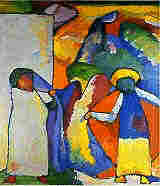
 W. Kandinsky, Improvisation VI(African), 1909
W. Kandinsky, Improvisation VI(African), 1909
Design Patterns : Elements of Reusable Object - Oriented Software
by Erich Gamma, Richard Helm, Ralh Johnson, John Vlissides
QA76.64.D47 1994
What is a design pattern?
Each pattern describes a problem which occurs over and over
again in our enviroment, and then describes the core of the
solution to that problem, in such a way that yhou can use this
soution a million times over, without ever doing it the same way
twice.
In general, a pattern has four essential elements :
-
The pattern name is
handle we can use to describe a design problem, its solutions and consequences
in a word or two.
-
The problem describes
when to apply the pattern. It explains the problem and its context.
-
The solution describes
the elements that make up the design, their relationships, responsibilities,
and collaborations.
-
The consequences are the results and trade-offs
of applying the pattern.
The Catalog of Design Patterns
-
Abstract Factory Provide
an interface for creating families of related or dependent objects without
specifying their concrete classes.
-
Adapter Convert the
interface of a class into another interface clients expect. Adapter lets
classes work together that couldn't otherwise because of incompatible
interfaces.
-
 Bridge Decouple an abstraction from its implementation so that the two can vary independently.
Bridge Decouple an abstraction from its implementation so that the two can vary independently.
-
Builder Separate the
construction of a complex object from its representation so that the same
construction process can create different representations.
-
Chain of Responsibility
Avoid coupling the sender of a request to its receiver by giving more than one
object a chance to handle the request. Chain the receiving objects and pass
the request along the chain until an object handles it.
-
Command Encapsulate a
request as an object, thereby letting you parameterize clients with different
requests, queue or log requests, and support undoable operations.
-
Composite Compose objects
into tree structures to represent part-whole hierarchies. Composite lets
clients treat individual objects and compositions of objects uniformly.
-
Decorator Attach
additional responsibilities to an object dynamically. Decorators provide a
flexible alternative to subclassing for extending functionality.
-
Facade Provide a unified
interface to a set of interfaces in a subsystem. Facade defines a higher-level
interface that makes the subsystem easier to use.
-
Factory Method Define an
interface for creating an object, but let subclasses decide which class to
instantiate. Factory Method lets a class defer instantiation to subclass.
-
Flyweight Use sharing to
support large numbers of fine-grained objects efficiently.
-
Interpreter Given a
language, define a represention for its grammar along with an interpreter that
uses the representation to interpret sentences in the language.
-
Iterator Provide a way to
access the elements of an aggregate object sequentially withot exposing its
underlying representation.
-
Mediator Define an object
that encapsulates how a set of objects interact. Mediator promotes loose
coupling by keeping objects from referring to each other explicitly, and it
lets you vary their interaction independently.
-
Memento Without violating
encapsulation, capture and externalize an object's internal state so that the
object can be restored to this state later.
-
Observer Define a
one-to-many dependency between objects so that when one object changes state,
all its dependents are notified and updated automatically.
-
Prototype Specify the
kinds of objects to create using a prototypical instance, and create new
objects by coping this prototype.
-
Proxy Provide a surrogate
or placeholder for another object to control access to it.
-
Singleton Ensure a class
only has one instance, and provide a global point of access to it.
-
State Allow an object to
alter its behavior when its internal state changes. The object will appear to
change its class.
-
Strategy Define a family
of algorithms, encapsulate each one, and make them interchangeable. Strategy
lets the algorithm vary independenly from clients that use it.
-
Template Method Define
the skeleton of an algorithm in an operation, deferring some steps to
subclasses. Template Method lets subclasses redefine certain steps of an
algorighms without changing the algorithm's structure.
-
Visitor Represent an
operation to be performed on the elements of an object structure. Visitor lets
you define a new operation without changing the classes of the elements on
which it operates.
 W. Kandinsky, Improvisation VI(African), 1909
W. Kandinsky, Improvisation VI(African), 1909

 W. Kandinsky, Improvisation VI(African), 1909
W. Kandinsky, Improvisation VI(African), 1909
 Bridge Decouple an abstraction from its implementation so that the two can vary independently.
Bridge Decouple an abstraction from its implementation so that the two can vary independently.